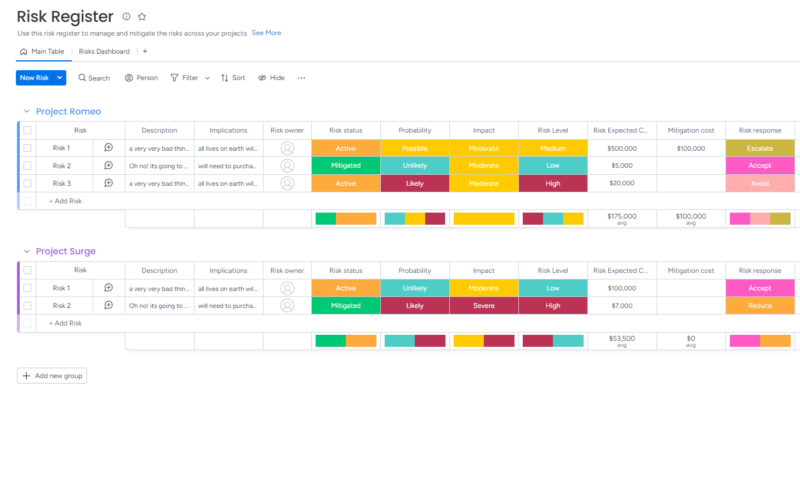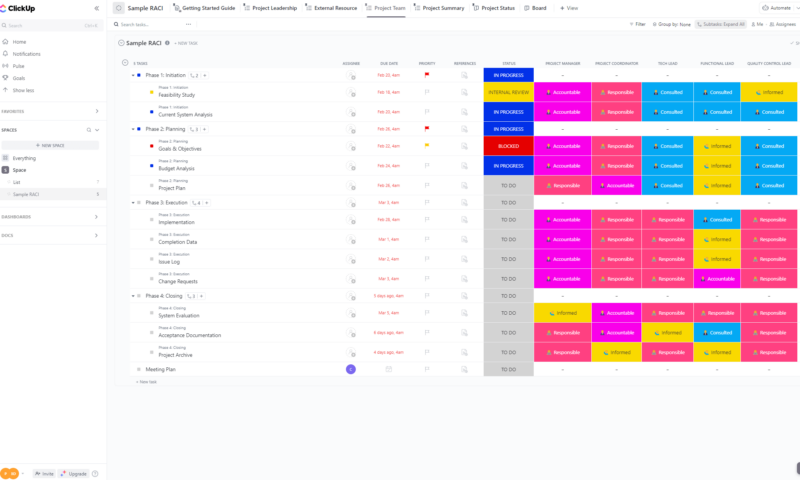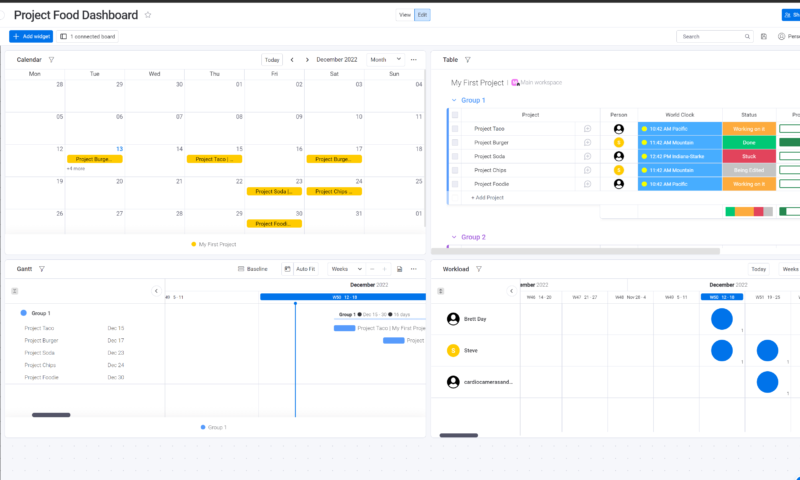What Is Critical Chain Project Management in 2025? Meaning and Examples
Critical chain project management (CCPM) is a popular methodology that companies use in the manufacturing and construction industries. Its ability to increase efficiency and manage resources makes it a valuable tool. Join us as we explore CCPM further.
When used with the best project management software, critical chain project management (CCPM) can help project teams manage resources, control scope creep, increase efficiency, and handle project constraints and risks. We’ll look closer at CCPM and explain why you should consider adopting it if you work in the manufacturing or construction industries.
Below, we’ll introduce the methodology, explain the underlying theory of constraints, show an example of a CCPM schedule and give tips to help you implement the methodology in your workplace.
CCPM Meaning: What Is Critical Chain Project Management?
Developed by Eliyahu M. Goldratt in 1997, critical chain project management (CCPM) is a project management methodology that focuses on monitoring project tasks, resources and task dependencies.
A fundamental concept in CCPM is the theory of constraints (TOC). Covered later in the article, this theory examines limiting factors and explores how to systematically improve constraints that impede project progress.

utilize Gantt charts to create project timelines.
The goal of CCPM is to identify project steps, timelines and the resources needed to complete the project. Once a project plan is made, project managers should have a robust roadmap. The roadmaps are then plotted on a Gantt chart to clearly show due dates and dependencies. This helps ensure that projects finish on time and within budget, and aids in avoiding scope creep.
Managers use CCPM as an alternative to project management methodologies like Waterfall and Critical Path, which the Project Management Institute covers in its Project Management Body of Knowledge (PMBOK) and Project Management Professional (PMP) course. CCPM is favored because of its focus on resource management.

the longest path to project completion.
The critical chain is the longest sequence of tasks required to complete a project. Unlike the critical path method, which works on the assumption of unlimited resources, CCPM factors in the resources (people, equipment and materials) required to complete the project.
CCPM also uses buffers (which we’ll cover later) to ensure that projects run smoothly. A project manager places buffers within critical and feeder chains to add extra time to tasks (if needed) and to make sure that all tasks and activities have the required resources for completion.
Critical Chain (CCPM) and the Theory of Constraints
The critical chain method makes it clear that identifying and resolving constraints is a key component of managing projects; this is where the theory of constraints comes into play. TOC aims to improve processes and systems by finding constraints that impact production or work. This is achieved by plotting how to fix the issues on diagram trees or mind maps.

diagrams that show current constraints.
An example of a constraint would be an electronics manufacturer wanting to produce 1,000 televisions daily. The company has five machines that can produce 200 units each, but one isn’t working correctly and can only produce 50 units per day. Until the constraint (or weak link) is fixed, the 1,000-unit goal is unachievable.
Many other types of constraints can derail a project schedule, blow budgets and hinder overall project success. We’ll examine some other constraints below.
Buffer Types in Critical Chain Project Management
Project buffers work to ensure that critical chain tasks have no resource constraints and plenty of extra time to help you stay on schedule, even if unforeseen events occur. Below, we’ll look at the three project buffers that leaders must build into the critical path and feeder timelines to help their project team stay on track.
What Are the Steps in Critical Chain Scheduling?
Many manufacturing and production juggernauts, like Mazda, Eli Lilly and IBM [2], use the critical chain project management method to run their projects successfully. The following seven steps could help you achieve CCPM success, too.
CCPM Scheduling Example
Let’s examine a schedule for a simple project to paint a room. The schedule uses the same methods that would be used to create a detailed CCPM schedule for a complex project.
Start by writing down all the tasks and required resources associated with the project. Next, estimate task durations using aggressive estimates. For example, buying paint could take two hours or more if you want to visit a boutique DIY shop across town, but you can say with 50% certainty that it would only take 35 minutes if you visit a local big-box retailer instead.
| Project Task | Task Length* | Previous Task(s) | Required Resources |
|---|---|---|---|
| 1. Buy paint, brushes & other supplies | 35 | N/A | Person to buy supplies, car for transport, money |
| 2. Prepare the room for paint | 10 | 1 | One person, ladder, masking tape |
| 3. Mix the paint | 5 | 1 | One person, paint stirring stick |
| 4. Paint the walls | 60 | 1, 3 | One person, paint, paintbrushes, ladder |
| 5. Let the first coat dry | 180 | 4 | N/A |
| 6. Apply the second coat | 60 | 4, 5 | One person, paint, paintbrushes, ladder |
| 7. Paint the trim | 30 | 1, 3, 6 | One person, paint, paintbrushes |
| 8. Remove the masking tape & clean up | 30 | 2, 6, 7 | One person, trash bags |
Then, figure out how to shorten the project duration by completing tasks in tandem. For example, while one person prepares the room for paint (a critical task), another could mix the paint so it’s ready to be used. Mixing the paint would be moved from the critical chain to a feeder chain that rejoins the critical path at step four: painting the walls.
After that, you’ll add your buffers. The total time needed to complete tasks in this sample critical chain is 405 minutes, so you’d add a buffer of 202.5 minutes to the end of the project. You’d then add a buffer of 2.5 minutes to your feeder chain, as the task of mixing paint takes five minutes. The buffers will help keep you on schedule should you run into problems.
You’ll also need to note the previous or dependent tasks so that you can determine what needs to happen before the next task begins. This is an oversimplification of what can be a complex project management technique, but it should give a good idea of what a schedule in CCPM looks like.
Tips to Follow for Successful Critical Chain Project Management
If you have decided to implement the critical chain methodology, the following five tips will help ensure that critical chain activities and project progress don’t suffer.
- Use decentralized planning: Critical chain project management works best with organizational structures that favor decentralized planning. Decentralized planning allows middle managers and team members to make important decisions, enabling teams to remain agile and respond to issues faster.
- Don’t pad individual tasks: It’s easy to fall into the trap of padding individual tasks that you think will take longer to complete. Instead, build your buffers and create a shared buffer pool. This will allow you to see which tasks are falling behind schedule and which employees may need help.
- Don’t overwork individuals: Avoid the habit of resource overloading. Pushing team members to their absolute limit will lead to burnout, mistakes, low morale and low-quality work. This is why assigning one task per team member and avoiding multitasking is essential in CCPM.
- Optimize resources: If you want tasks to be finished on time or ahead of schedule, let team members focus on their work. Don’t overload them with meaningless meetings, stop unnecessary interruptions, and assign less-critical items like document production to non-critical team members.
- Ensure everyone understands the critical path: Project tasks that are on the critical path will have the majority of the constraints. Part of the critical chain process is ensuring that everyone knows what the critical path is, what constraints should be expected and how to handle them so that work can continue at a steady pace.
Critical Chain Project Management vs Critical Path Method
It can be easy to confuse critical chain project management (CCPM) with the critical path method (CPM). Although they sound similar, CCPM is more advanced and introduces tools to help project managers manage critical resources and limit the chances of scope creep. The table below lists the differences between these traditional methods of managing projects.
| Critical Chain | Critical Path |
|---|---|
| The time to complete individual tasks is estimated with 50% confidence. | Tasks in the critical path are estimated with 80-90% confidence, which leaves little room for error. |
| Individual tasks don’t have buffers attached to them. Instead, a buffer pool is added to the end of the project that all tasks can utilize. Feeder buffers are also located at predetermined points. | Task slack or buffers are built into each task to help them stay on track. |
| Leaders focus on resource availability, potential constraints and the well-being of the entire team. | Project managers focus all of their time on specific tasks that drive the project forward, not on examining potential constraints and resource availability. |
| Tasks are only assigned one start and finish date. | Tasks are assigned early and late start and finish dates. |
| If a task is finished ahead of time, the next task may be started, and any saved time will be added to the buffer pool. | If a critical task is finished early, the next task cannot start before its early start date, otherwise the entire project schedule will be affected. |
Final Thoughts
Installing a critical chain project network can help managers schedule tasks for complex projects, effectively manage resources and scope creep, and ensure that projects don’t slip past their delivery date.
Implementing CCPM can be time-consuming, and by design, CCPM isn’t as flexible as Agile frameworks. However, it is still one of the best methods for completing challenging manufacturing and construction projects. If you need software for your next construction project, check out our roundup of the best construction project management software.
We hope you found our guide to critical chain project management helpful. Do you use the CCPM method? What project management software do you use to help manage CCPM projects? Do you have any tips for successfully implementing CCPM? Let us know in the comments. Thanks for reading.
FAQ: CCPM Definition
Critical chain project management is a methodology that project leaders use to plan tasks, manage resources, remove project constraints and prevent scope creep.
Both are considered traditional project management methods and are similar in some ways, but they do have a few key differences. CPM uses a critical path to guide teams to the end of a project but doesn’t account for resources or constraints. CCPM also uses a critical path, but there is an increased focus on resources and potential constraints that could delay the project.
The benefits of critical chain project management include enhanced resource management, better focus on individual tasks, increased risk management measures and project buffers.
The most critical thing in project management is delivering your project on time — on or under budget — and appeasing stakeholders and clients.
Sources:





